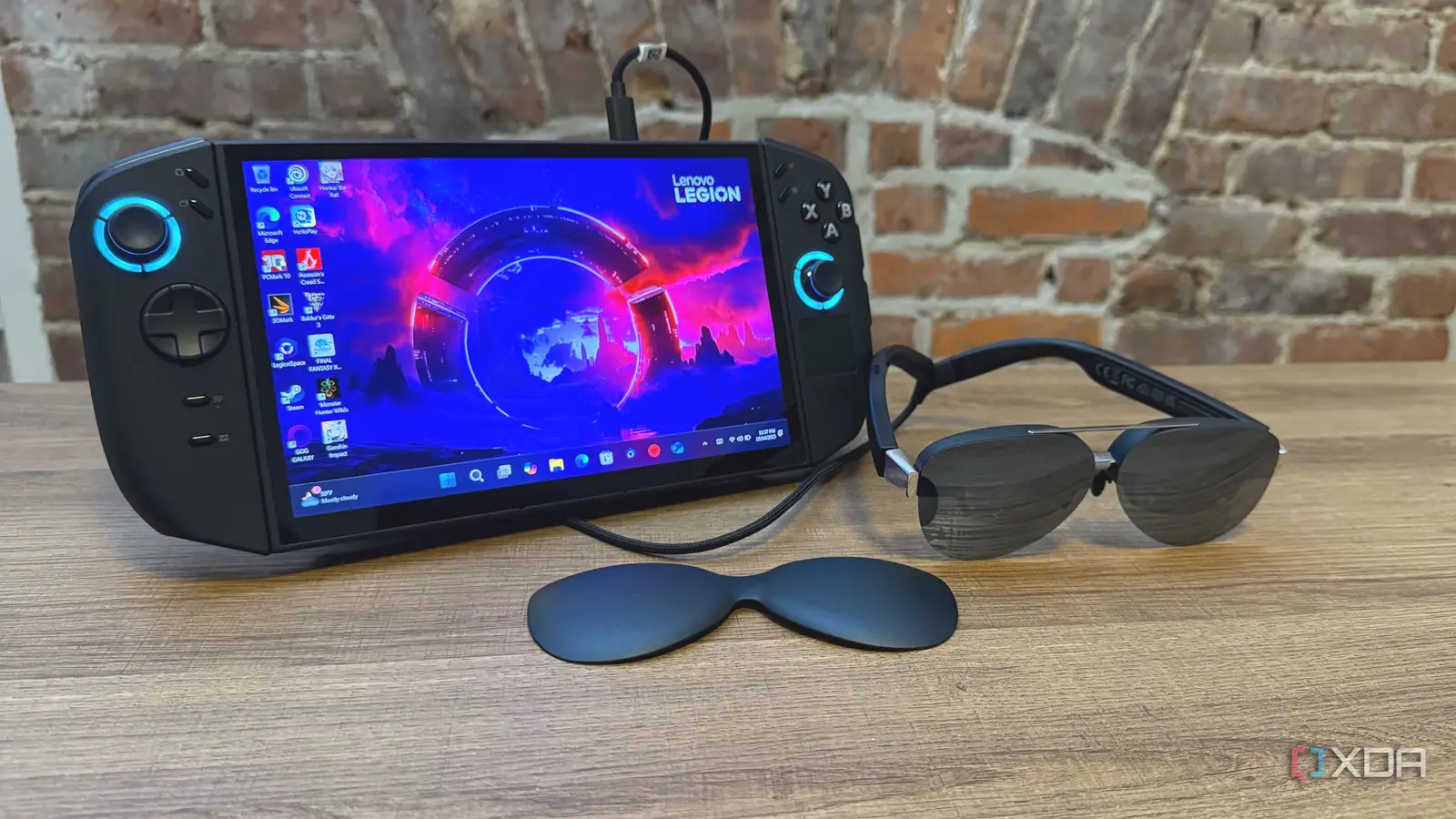Copyright XDA Developers

AR and smart glasses aren't exactly new. Nor is it new to use them with a gaming handheld, but glasses technology has improved significantly over time, and no set of glasses makes that more obvious than the Lenovo Legion Glasses Gen 2. This second iteration of Lenovo's AR facewear features a 126-inch virtual display, USB-C connectivity for streamlined video output, edge-to-edge visuals, and lighter lenses for increased comfort. While the Legion Glasses Gen 2 can be paired with any device, whether that's a laptop or desktop, tablet, or handheld gaming PC, the glasses really shine when connected to a gaming handheld like the Lenovo Legion Go 2 or Steam Deck. After all, keeping good posture with a gaming handheld can be tricky, and one easy solution is to add a virtual display instead of the built-in handheld panel. And that's the sort of benefit that makes the Legion Glasses Gen 2 an especially attractive accessory for handheld gamers. Lenovo Legion Glasses Gen 2 pricing and availability Just how much do you need to set aside for new AR face gear? Lenovo's Legion Glasses Gen 2 feature two 0.6-inch Micro-OLED displays built into the frame. These displays offer a 126-inch virtual display with a 43.5-degree Field of View. The second-gen Legion Glasses retail for $299. This price tag might seem a bit steep for a pair of AR glasses, but it is actually a pretty solid price point. Most audio-only AR glasses retail for about $150-$300, and the Legion Glasses 2 do have 3D functionality that some more basic models lack. And at the high end, some AR glasses can retail for over $1,000. The popular XREAL AR One glasses retail for $499, though that model does have a larger spatial screen and features the XREAL X1 chip, while the Legion Glasses Gen 2 are a bit more basic than the XREAL AR One glasses. Legion Glasses Gen 2 design: Highs and lows Easy to adjust, but aviator style is tricky to pull off The Legion Glasses Gen 2 feature an aviator-style design, which pairs well with the 0.6-inch micro-OLED displays and pass-through mirrored lenses. While they do look sleek, aviator-style glasses can be hard to pull off depending on your face shape. And that's probably my only real complaint. If the Legion Glasses Gen 2 came in another style, I certainly wouldn't choose the aviator-style AR glasses over a more traditional rectangular or wayfarer style. However, the Legion Glasses Gen 2 are easy to adjust. The default positioning of the nose pads wasn't ideal for my face shape, but a few minor tweaks got me the perfect fit. And there's no real trick to adjusting them; you just manually bend the nose pads the same way you would with a standard pair of glasses or sunglasses. And as far as tech goes, the Legion Glasses are a great balance, offering the necessary base features without overcharging you. The second-gen Legion Glasses have a smooth 120Hz refresh rate, which can help alleviate eye strain from screen flicker, which is better for your eye health overall. Especially when you consider the fact that AR glasses put screens just a few scant inches away from your eyes. And thanks to that 120Hz refresh rate, you've got plenty of speed for a smooth gaming or video streaming experience, no matter what hardware you've got the Legion Glasses hooked up to. Sure, it's not ideal for competitive gaming, but for a casual game experience, 120Hz is more than quick enough, and there's little latency to worry about, so you don't need to avoid games that rely more on twitch-reflexes like first-person shooters. The Legion Glasses' micro-OLED lenses themselves offer a great deal of color saturation and contrast, though you can lose some of the detail when utilizing the Legion Glasses as pass-through lenses. For longer, in-depth gaming sessions or video streaming, using the included magnetic lens cover allows you to fully immerse yourself in the Glasses' display with fewer background distractions and interference with the vibrant micro-OLED panels, offering a much richer experience. While Lenovo classes the Legion Glasses' virtual display at 126-inches, it's difficult to fully measure. But with the glasses in place, the virtual display does take up most of your field of view. I found at the normal display settings the Legion Glasses' virtual display was almost too large, as it put some UI elements higher in my field of view than I found helpful, but some tweaks to the display settings and game UI settings often helped alleviate this. Unfortunately, the Legion Glasses Gen 2 only have three buttons to control screen brightness and volume, so you do need to go into your device's display settings to make any tweaks, rather than make adjustments on the glasses themselves. Legion Glasses Gen 2 and Legion Go 2: The perfect pair The Legion Glasses make up for one of the Legion Go 2's biggest faults While the Legion Glasses Gen 2 can be used with any handheld, desktop, laptop, or tablet, I took them for a test drive on the Legion Go 2 first because it's the bulkiest handheld I have on hand. My biggest complaint about most gaming handhelds is how heavy they are to use, which often leaves me contorting my body into weird pretzels to balance them on my knee while gaming. While this alleviates the hand and wrist strain, it leaves me with a nasty kink in my back. Adding the Legion Glasses Gen 2 meant I could still support the handheld with a knee or two and avoid craning my neck down to stare into my lap the whole time. It does take some getting used to using AR glasses with a handheld device, especially when looking at UI elements positioned in the corners of the display. Some quick adjustments to the game UI or the AR glasses' virtual display can help you get a more comfortable field of view, though if you stick with the full virtual display setup, it only takes a few minutes to stop tilting your head to see the corners of the virtual display. So it's not a particularly sharp learning curve, and the posture benefits are no joke. Even just a few minutes of using a handheld device propped up on a knee or a table is enough to start feeling strain in my neck and back, but I can easily game for over an hour without the same pain when using AR glasses. But it's not just handhelds like the Steam Deck or Legion Go 2 that benefit from AR glasses. Replacing your desktop monitors with smart glasses can be a worthy upgrade for increased productivity or a more immersive gaming experience. Should you buy the Legion Glasses Gen 2? Is this the perfect $299 accessory for you? You should buy the Legion Glasses Gen 2 if: You have a gaming handheld but no pair of AR glasses. Most gaming handhelds are awkward for you to comfortably hold and use at the same time. You want a larger screen for your laptop, tablet, handheld, etc. You should NOT buy the Legion Glasses Gen 2 if: You already own AR glasses. You don't own a gaming handheld or tablet that could benefit from a virtual screen. $299 for an accessory is too steep a price for you. While I don't think $299 for a pair of smart glasses is too steep, if you've got to stay on a tight budget, there are cheaper ways to augment your handheld gaming experience. Getting a lap desk or a pillow to prop up your handheld can make it easier to game for longer sessions, and aftermarket grips can help you get a more ergonomic position for your hands. But if you've got the spare $299 and a gaming handheld, the Legion Glasses Gen 2 (or a similar pair of AR glasses) are absolutely worth the investment. The posture benefits alone are practically priceless. And while you can find cheaper options, the Legion Glasses Gen 2 are a solid at a great price to performance ratio without all the unnecessary features of a more luxury pair of glasses, making them an ideal choice as a handheld gaming accessory.



